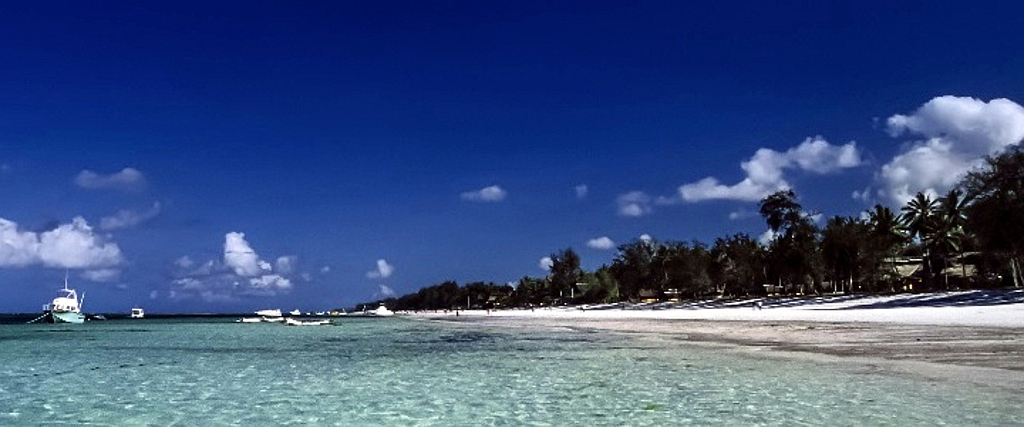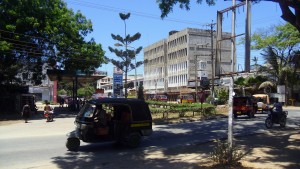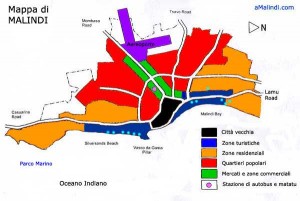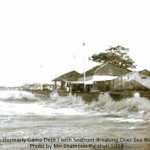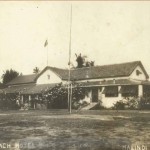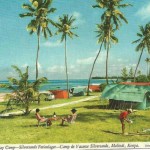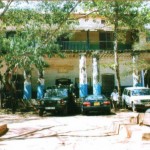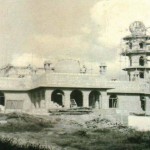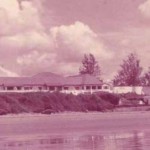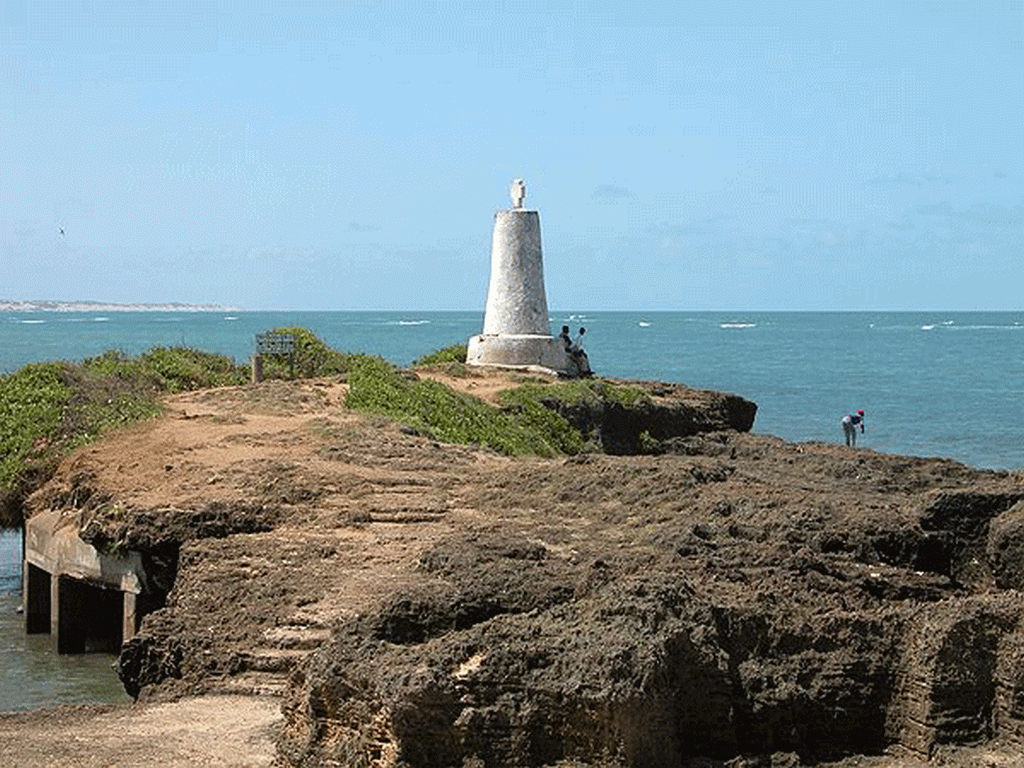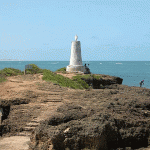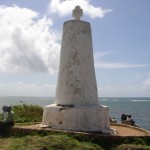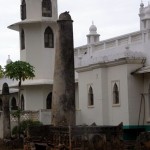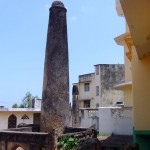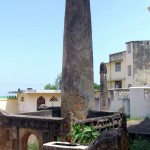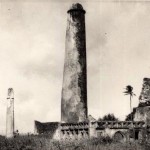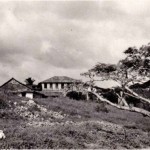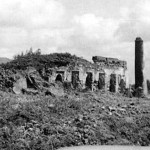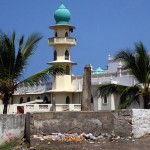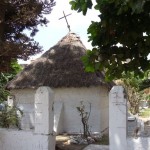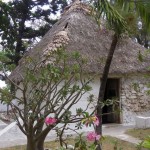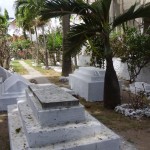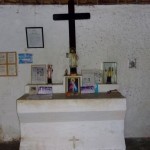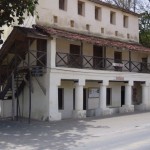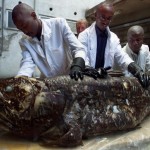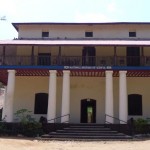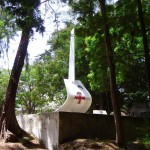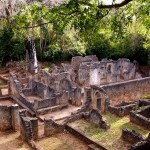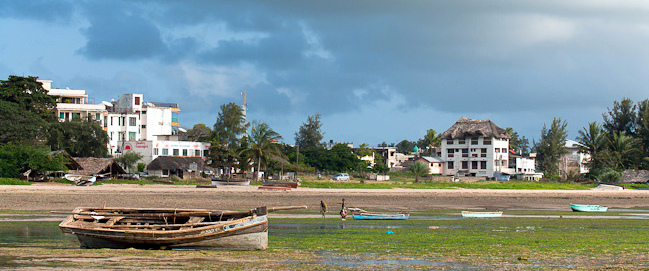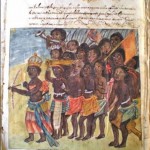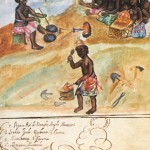History of Malindi
Malindi, located about 120 km northeast of Mombasa, is one of the most famous tourist towns along the coast at Malindi Bay now is the second largest city on the Indian Ocean coast of Kenya after Mombasa.
Ancient coastal town founded around the 1st century AD and sort, as originally Arabic settlement and trading post, probably at Mambrui, North of the river Sabaki.
Although known under the Portuguese name of Melinde, some claim the origin of the Swahili name of Mali Ndi which means “lot of wealth”.
The population was 208,000 inhabitants in 2009 and is located in County Kilifi which, again in 2009, had a population of 1.11 million.
The Arabs established the current Malindi in the early 13th century. In 1414 the King of Malindi initiated diplomatic relations with China during the voyages of the Explorer Zheng He.
The April 15, 1498 (the year 918 of the Arab calendar) the Sheikh of Malindi al-Bauri, at war with Mombasa, he welcomed the great Portuguese explorer Vasco da Gama. He anchored three ships in the port of Malindi: São Gabriel, a caracca commanded by Vasco himself, São Rafael under the command of his brother Paulo and Berrio (later renamed São Miguel) commanded by Nicolau Coelho. It is said that Vasco da Gama never left São Gabriel, a three tree of about 200 tons with square sails and large red crosses.
The following year the East African ports were opened officially to Europe so the Portuguese established a trading post. At that time, the city was a wealthy Kingdom. The residents mingled with Arabs who were the ruling class and the city was surrounded by walls. The Arabs living inside the walls in stone houses, while Africans lived mainly in mud huts and trellis of canes with palm-thatched roofs.
The economy consisted of agriculture and trade with various ports in the Indian Ocean. Near Malindi there were large fruit plantations (lemons, oranges), coconut palms, sugar cane, vegetables and livestock. Slaves and ivory were exported. The city was an important port in East Africa.
In the early 16th century the Portuguese chose Malindi as a supply station for the Portuguese ships, so they built their own administration, gas stations and houses for their officials. In 1518 the Mozambique took over the role of Malindi as replenishment station for Portuguese ships because the Portuguese had trouble defending Malindi.
With the construction of the Portuguese Fort Jesus in the nearby town of Mombasa (1593) Malindi began its decline. The Portuguese administration and customs were transferred to Mombasa to Malindi authorities leaving. After the 1666 the Portuguese have lost complete control of the city.
The Sultan of Zanzibar Majir refounded Malindi in 1861 and its wealth has increased between 1861 and 1890. Arab Governors appointed by the Sultan of Zanzibar and supported by a garrison between thirty and one hundred and fifty Baluchi soldiers administered the city. After 1873 the slave trade became illegal, led to a decline in the agricultural economy, so the Arabs were willing to take part in the local wage-based Africans. The sultan of Zanzibar subsequently rented its territories, which included the Malindi region, to the British East Africa Association (see Republican Council of Mombasa).
In 1906, the new European Group began planting and export large amounts from their rubber plantations, but this ended in 1917 when rubber prices recorded a sharp decline because of overproduction in Malaysia. From 1925 to 1938, there was drought followed by flooding that led to a drop in agricultural production. However, there was a great increase in cotton production until 1935, when the price of cotton fell dramatically.
During the second world war there was a lot of economic development in the area of Malindi. At the end of 1944 the tourists coming from inland were returning, and the army was slowly retreating so that Malindi, once again, is returned to normal.
In 1960 the mass tourism using charter flights landed at Mombasa, Malindi was back on the world map. Malindi today is in the midst of a tourist boom, mainly due to its spectacular beaches.
The city is served by an airport and a national road between Mombasa and Lamu. The resorts of Watamu and Gedi Ruins (the remains of a Swahili town located in Gedi, a village near Malindi) lie South of Malindi.
In 1948, the ruins of Gedi were declared National Park in Kenya. The mouth of the Sabaki River lies in the North of Malindi. The national marine parks of Watamu and Malindi form a continuous protected coastal area south of Malindi. The area shows classic examples of Swahili architecture.
Malindi forms a city council with 13 neighborhoods:
Barani, Ganda/Mkaumoto, Gede, Gede North, Gede South, Kijiwetanga, Madunguni, Malimo, Malindi Central, Malindi North, Maweni, Shella, Watamu Town.
All of them are in the college of Malindi.
The city of Malindi has 20 informal settlements:
Umoja, Majivuni, Tototo, Shella, Mgandini, Kikombe Tele, Majengo Mapya, Mbuyu wa Kusema, Kwa Mdomo, Majengo Maskini, Maweni, Erani, Myeye Juu, Kibokoni, Kwa Chocha, Ganda, Ziwa the Furunzi, Bandani, Mtangani and Thalatha Meli .
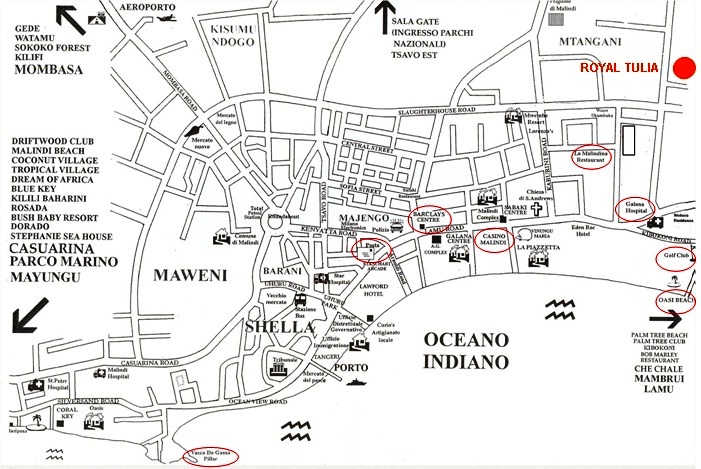 MALINDI
MALINDI
This seemingly quiet town had all passed with a monotonous bewildering alternation was dramas and fortune scenario worthy of the most exciting literary sagas. Its origins are quite uncertain although it is likely to date back to the 9th century. However, it is confirmed by the finds of porcelain that was inhabited by the Arabs in the 13th century. Later in the first half of the fifteenth century and the Chinese arrived 1492 was the Portuguese Navigator Vasco da Gama which after the hostile reception received in Mombasa, Malindi seemed an oasis of peace and tranquility.
At that time Malindi was a walled city of coral stone that boasted a population of six thousand inhabitants and for most of the 16th century merchant trade with the Portuguese, Arabs and Indians made her one of the richest and most prosperous cities on the coast.
In 1595-1598 Turkish mercenaries enter the scene, led by the terrible figure of the pirate Emir ‘Ali Bey (Bey Mirale) that seized the Portuguese possessions of Faza, Pate and Mombasa. Malindi was also besieged, but escaped the looting thanks to the cunning of a Portuguese captain, Mendes de Vasconcellos, who overnight became install two guns on a sandy islet off the besieged city. The Turkish fleet, believing to be bombarded by an army, he retired. The worst it seemed past it was only an illusion. Soon they came from the south coast of the echoes of enterprises of Zimba or Wazimba, a tribe of cannibals who had been able to put Mombasa on fire. In a flash they came upon Malindi and it was only thanks to the combined forces of Portuguese and local tribes that terrible Zimba were defeated and driven back.
In 1539 the Portuguese moved their bases in Mombasa, with a port with deep water and easier to defend, beginning the construction of Fort Jesus and since then began the slow and inexorable decline of Malindi.
The city went more and more to lose consistency, in 1634 it was already one-third as it was originally. Twenty-eight years later was invaded by Omani Arabs attracted by its strategic position perfect for controlling the coast.
About two hundred years later, the missionary Ludwig Krapf gave a daunting report Malindi had become a semi abandoned and swallowed by the vegetation. Despite its commercial decline Malindi was still very rich in agricultural products so that in 1861 the Sultan of Zanzibar gave the order to rebuild it and he sent a representative of the Imperial British East Africa Company to control its properties.
Towards the beginning of the century there was an attempt, in the area around Malindi, extensive cultivation of the rubber but due to the collapse in market prices due to the increasing competition from other producing countries, this project was soon abandoned. Only in the 30’s came the first European residents, including Mr. Pat Brady, who bought in 1932 an old house, which was built before 1914 by a European owner of a rubber plantation, transforming it into the first hotel in Malindi, the Palm Beach Hotel , today’s Blue Marlin, and the commander Lawford who built the eponymous hotel.
During the war, in 1940, Malindi was bombarded by two biplanes Italian and although fortunately only a fraction of the bombs exploded. After World War II, Malindi started to become a holiday resort for the country farmers in the north and later in 1960 finally exploded as a seaside resort.
Today Malindi experiencing a time of economic expansion and tourism. While retaining the charm of a “fishing village” offers countless choices hotel high-level international restaurants and all the services of a famous tourist destination. The natural beauty of the coast, the many beaches and bays lined with palm trees, ideal tropical climate and the magic of the Indian Ocean make it the ideal place for a dream vacation.
THE OTHER MALINDI
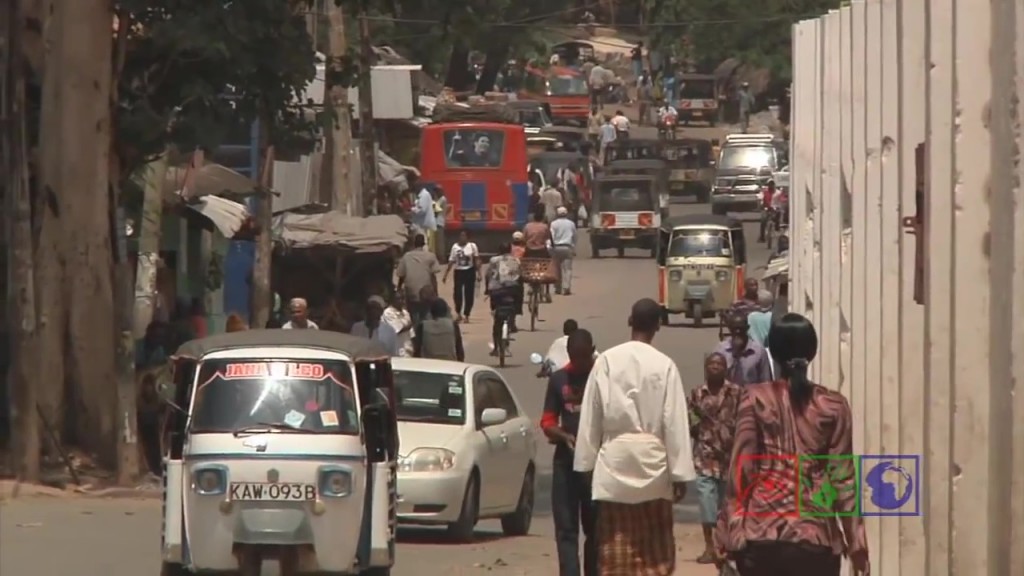
PLACES OF HISTORICAL INTEREST:
Vasco da Gama Pillar or Cruz Padrão – Pillar Tombs – Portuguese Chapel – Home of the columns – Malindi Museum – Gedi Ruins
At the end of the 15th century the Portuguese landed on the shores of Kenya: Vasco da Gama, which remains a landmark in the history of Malindi, was their forerunner. A few years had passed since the discovery of America and the rich Arab traders of the East coast of Africa is not viewed favourably the arrival of competition, but while all refused the Portuguese hospitality the Sheikh of Malindi welcomed them with open arms, so that helped da Gama indicated, thanks to an expert Navigator (the Yemeni Ahmad ibn Majid ibn Muhammad al-Sa al-ʿ Jaddi al-Najdi) up the road in India.
In memory of that acceptance in 1499, on his return trip to India, the Portuguese navigator built the Vasco da Gama Pillar or Padrão Cruz, a pillar surmounted by a cross, which was erected as a reference for sailors (Padrão means pillar navigation. The Padrãos taking different meanings as the same travel across the African continent. The Padrãos have not only acted as navigational aids Portuguese, but proclaimed the land around them as a Christian and member of the Kingdom of Portugal). The pillar (Padrão Cruz) was originally built by Vasco da Gama out of the Palace of Sheikh town (where today there are the old courts or just off near a mosque in the old district of Shella on the waterfront), but its Christian connotation He caused discontent among Muslims and was soon removed and moved, under Portuguese insistence, in the current location, in the southern point of the bay of Malindi, by monks in the sixteenth century. It is one of the oldest monuments in Europe remained in Africa. The Christian cross is the original limestone of Lisbon, while the thin column, always limestone Lisbon, it has been replaced with a cone-shaped pillar in local coral. In 1873, Captain Malcolm did fill the cone with the concrete pillar to support the cross. In 1986, the concrete pillars were put under the great coral bed to support the breaking in pieces of dead coral and to stop the fall in the sea column. But the arrival of the Europeans was the beginning of the end, and coincided with the start of the slave trade, with the sacking of the city and the consequent decline of Malindi, which in those years knows the darkest period of its history.
The Pillar Tombs: between town and Pier. These are two pillar erected tombs in the early 15th century on the hill near the Arab market, probably just outside the city walls. Many believe that these pillars, in design, are a phallic representation, but many Arabs don’t agree. They are associated with the phallic pillars of the Galla or monolithic pillars of Imerina and Betsileo of Madagascar. The monument is located east within the walls of the Juma Mosque (Jamia), also home to a Muslim cemetery, is unobtrusive and architectural interest. The taller of the two tombs dating back to the beginning of the 15th century and was built for the burial of Sheikh Abdul-Hassan called local. The Juma Mosque (mosque of Friday prayer) overlooking the market of slave traders who operated until 1873, when the slave trade, but not slavery itself, was banned by the British.
The Portuguese Chapel: located at the south end of the waterfront port in the Shella area on Mama Ngina Road in the historic center of Malindi. Built by the Portuguese in 1498 to bury two sailors (the two tombs are unnamed), it was the first Christian church known in East Africa defying age to remain an important historical symbol of religion and continuity.
The chapel, which measures five by five meters, has white walls made of coral rocks and sand. There is a security “window” in one wall that would have been used to see enemies from the ocean. The church also has an altar with Catholic religious paraphernalia, two chairs and eight wooden benches on a cemented floor. It can accommodate 40 people seated and 50 to 60 standing.
Originally the internal walls were decorated with paintings which unfortunately have recently been covered with a coat of white paint (in particular on the southeast wall a fresco was painted representing the Crucifixion that came to light in 1933 during the restoration of the chapel itself) . It was visited by St. Francis Xavier (Saint Francis Xavier of Spain), one of the founders of the Jesuits in 1542 while traveling to India, where he buried one of the sailors who died on his ship. Outside the chapel, now dedicated to him, there was a cemetery of Portuguese tombstones, but today there are also many more recent tombs (in total there are 36) including that of the Malindi pioneer commander Lawford of the Lawford Hotel and J Bell Smith, the first British administrator in Malindi buried here in 1894. This cemetery is the last resting place of Charles Arnold Frank Mathews, buried in 1968. He was the son of Canon Mathew, a pioneer tea grower in Kericho who drowned. at sea in Malindi while on vacation.
Despite having been abandoned between 1593 and 1893, the chapel and its history have stood the test of time.
Now, under the supervision of the National Museums of Kenya, the chapel of San Francesco Saverio is one of the most important places of worship in Kenya: a reminder of centuries that have come and gone, a vanguard of the Christian faith in Kenya.
The House of Columns, a good example of traditional swahili architecture, is located in the porto (Vasco da Gama Road) and is inside an ancient Portuguese construction with columns where is hosted the Malindi Museum. The building was originally built in 1891, and in recent years has served as the Office for the Kenya Wildlife Service and is now a national monument that has been lovingly restored by the National Museum of Kenya, thanks to funding from the German Embassy. The House is on three floors with large rooms, stairs and wooden shutters. Home town history revisited through books, charts and GEO, documents, photographs and drawings of monuments and houses and other information and evidence of Portuguese domination in particular. There are many interesting exhibits and labeled, including sacred artifacts carved wooden Gohu people (a secret society composed of men from the Giriama people, in addition to those known as Habasi and Kinyenzi), used as a link between the living and the dead. Sacrifices were made to them, in preparation for the harvest and sowing. There are a couple of boards on Vasco da Gama and his arrival on the coast in the 15th century, and a poster dedicated to ‘ Discover Islam ‘ with information about how men and Muslim women live their lives. On the ground floor of Mombasa photographs emerge of how it was before and how it looks today, while in one of the upper floors of the Malindi Museum, the library is where you can see local books.
The Museum also displays some scientific discoveries supported by many browsers. Also shows a strange specimen of Coelacanthus (Latimeria chalumnae), a prehistoric fish that you thought was gone with the dinosaurs more than 65 million years ago, but in recent years some specimens have been found around the Eastern and southern coast and Indonesia. The huge 1.7 m fish was caught at a depth of approximately 185 m off the coast of Malindi in 1991 and has fleshy fins supported by bones moving like the arms and legs. Scientists believe they could be a part of a chain of creatures that have evolved and moved to live on Earth about 360 million years ago. Was identified as a coelacanth adult female, and amazingly it was found carrying eggs up to 9 cm in diameter (the celacanti does not lay eggs, but they are viviparous, i.e. eggs without shell, hatch inside the mother’s body).
National Museums of Kenya: home to the Malindi Museum Society which is to acquire and restore historic buildings in Malindi as museums. The building is also home to the Malindi Cultural Complex that deals mainly with promoting tourism in the region.
Gedi Ruins: located 19 km south of Malindi Gedi ruins are all that remains of an Arab city built in the late 13th century and abandoned following an attack of the Galla or for lack of water. The visible part of the city dates back almost all of the 15th century and at that time its population was supposed to be about 2500 units. The legend says that the city is inhabited by ghosts so that Commander Lawford used offer a weekend for two in his hotel who had dared to spend a night alone in Gedi.
Vasco da Gama Pillar or Cruz Padrão, Malindi
ZIMBA, the ravagers of Africa!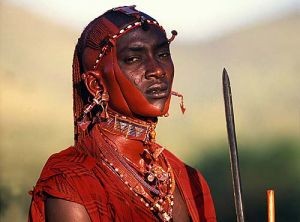
A nomadic and warrior for two centuries (XVI and XVII) devastated Africa. Were the fierce Zimba (or Jagga for the Portuguese) who thought they were invincible thanks to an ointment prepared by sorcerers after putting in a mortar babies alive and other secret ingredients. (In the picture a Masai Warrior. They would be among the descendants, together with the Zulu, Zimba)
But who are these Zimba?
Originating in the Great Lakes area and the Kilimanjaro between Kenya, Uganda and Tanzania moved far and wide throughout Africa, destroying massacring and pillaging all the people that they met on their way from Sierra Leone to the Zambezi, from Ethiopia to the Kalahari desert.
They attacked the Europeans in Congo forcing them to abandon the city of Sao Salvador and came up in Abyssinia and the coast of Zengi (see Zanguebar coast), to Kilwa where passed to three thousand Muslims.
They were preceded by a reputation that was even more terror: populations were said to be cannibals. In battle were over men and women also sorcerers who’s Neha dressed in crocodile skin throwing spells.
The warriors were decorated with feathered hats, horns, bones, human skulls, jaws or feet of animals while the red feathers, which corresponded to the number of enemies killed, were an exclusive privilege of the King.
Finally, their violent devastating push was exhausted and they knew their end on the battlefield at the hands of the army led by the queen of Ndongo (Angola), Nzingha Mbandi Ngola (also known as Nzinga or Zingha), who survived and enslaved with the Zimba he took Matamba from the Portuguese, founding a free state.
THE EPIC OF ZIMBA (Jaga o Ba-Yaka)
Many legends and traditions speak of successive waves of migration of peoples shepherds. The Hima, for example, invaded our current Uganda 1300 and it seems to have been the founders of large fortified towns, such as Baker and Kabengo. These cities were surrounded by defensive ditches, dug into the rock at times. Inside, the House and the enclosure of livestock were in turn protected by moats. The cities were often extended more than a kilometer and encompassed a central Hill, as in another part of the continent the citadels Hausa and Yoruba. Like those, they repeat the fortified centres of employment, built by an invader. According to the places and moments, the invasions were based or shepherds peoples destroyed city. It appears that has been destroyed by Engaruka arrival of nomadic shepherds.
The Jaga (is pronounced almost like “Giaga”) were a people that sec. 16TH and 17th began to fire much of the African continent, from Sierra Leone to the Zambezi, from Ethiopia to the Kalahari desert. It is believed that they came from the North of present-day Congo-Zaire. Their memory has been handed down in the various regions and they are considered as the ancestors of Ba-Yaka in Congo, Angola, Jinga of Zambezi, Azimba of Madagascar, the Vazimba Galla-Oromo of Ethiopia, Fundhi of Sennar, Timene Sierra Leone, Zimbabwe, Makalaka of Zulus, etc.
Guinean history professor Ibrahima Baba Kaké identifies them as close relatives of the present Masai. It seems likely that they originally came from the Great Lakes region and Kilimanjaro. Their invasions shook the existing ethnic groups and led to the formation of new States. According to Adolf Bastian, the first mention of their appearance in the Congo was in 1491. The first authors report that they called themselves Agag or Gaga, name changed by the inhabitants of the Congo Giaka (Ba-giaka) and Jagga by the Portuguese.
According to father Cavazzi, they carried that name already in the homelands, where it was pronounced “Engangiaghi”.
The Wachanga (Chaga or Chagga, Jagga, Jaga, Dschagga, Waschagga), at the Kilimanjaro, would their descendants stayed in the homelands. During their invasions they were known in many countries also with the name of Zimba or Ma-Zimba, from the name of their leader Zimbo.
In the Congo they defeated all the troops who tried to stop them, and finally King Alvaro I (1568-1587), was forced to abandon his capital of São Salvador (Mbanza Congo) to take refuge on an island in the middle of the Congo River , called “Island of the horses” for the large number of hippos that were there. Many inhabitants fled to the mountains.
Mbanza Congo is a city in Angola, the capital of the province of Zaire. It was the seat of Manikongo, the ruler of the Kingdom of Kongo. From 1570 to 1975 it was known as São Salvador (in Portuguese).
Towards 1570, the Jaga-Zimba evacuated the Kingdom of the Congo and divided into several groups, some of which came to Abyssinia and in 1587, coming from the north of the Zambezi River, on the Zanj coast (or Zengi, see Zanguebar coast), in Kilwa, where three thousand Muslims passed by the spear (Zanj coast, is an old name of the part of the East African coast that is distributed today between Mozambique, Tanzania, Kenya and Somalia).
Then a horde of 15,000 cannibals Zimba invaded Mombasa. Anthropophages devastated the island and massacred the inhabitants. Having decimated the population of Mombasa, they attacked Malindi, but the king of that city defended himself and, with the help of the then numerous, warlike and ferocious tribe of the Segeju, he managed to make them a carnage.
The surviving Zimba left for the west. Zimbo himself reached the Cape of Good Hope and then went up the Atlantic shore, to Kunene, where he founded a new kilombo (camp).
The terrible Zimbo died while preparing a new military campaign, but forged the ruthless cruelty of his daughter Temba N’dumba, so much so that the fame of ruthlessness inherited, from cannibalism to infanticide, as well as in inhuman behavior in battle, was the basis of terror that Jagga troops inspired. Even their successors, Kulembe and his wife Bombaikase-Kizura, left behind them an aura of ferocity, so much so that Father Giovanni Antonio Cavazzi speaks of them as “bloodthirsty monsters“.
The reputation of ruthlessness inherited by Zimba had them credited to cannibalism, infanticide, inhumane behavior in battle, and was largely behind the terror that inspired their troops. Cavazzi describes a “horrible ointment”, “maji-to-samba”, which was made by pounding live babies in a mortar. It was used by Temba-Ndumba to become “immortal and invincible“.
In the middle of the century XIX, Bastian heard that a pond near the ancient capital of the Congo, São Salvador, had been created by the tears that the jaga invasion had torn from the god Unga, while the weeping of the Kasutos and Inkisi had formed the rivers that still carry the their names.
He was shown to the market place where the Jaga feasted with human flesh.
As the Zulus a few centuries later, the Warriors Zimba and raided did in the length and breadth of the South-central part of the African continent. Subdued many peoples, who left a legacy of some loanwords, similar to the roots of the modern language of the Masai, and at least partially their military organization and their form
Religion, the cult of the dead, was very important in the company jaga. Their priest, nganga-ia-ita, made of crocodile skin belts that were supposed to protect against evil.
In honor to the King and the Princes, the high priest (nganga-ia-kimbanda) practiced sacrifice (kiluvia).
Military plane, the jaga strategy was based on two points:
– surprise attacks, accompanied by a series of ruses, offensive manoeuvres alternated with facings.
A narrow discipline allowed them to regroup or disperse quickly ordered maneuvers.
– fortified camps, from which caused the opponent to attack the battle from positions of strength. The Jaga fought on foot, and they had no horses.
Using bows and poisoned arrows.
A few prisoners were caught, but those who could become good warriors or slaves. Each warrior had its own hallmark: a feathered headdress, horns, bones, beaks or legs of animals, painted ornaments. Red feathers – whose number matched that of enemies killed – were a privilege of the King.
Women also ranged combat jaga along with men.
The camps (kilombo) replaced villages, as it will then be for the kraal of the Zulus.
The kilombo, described by type Cavazzi included seven districts:
1 – In the middle of the camp were the residences of the King and his councillors, surrounded by Palisades.
2 – The neighborhood of ngolambole, General of the guards, also known as mutue-a-ubungo (Captain). He was the first officer of the King, the one who attacked first, and that he was driving. Accompanied by a shinghila (soothsayer), chose the site where found the kilombo, traced his ways and called all details for construction.
3 – The neighborhood of tandala, Commander of the rearguard, revered as a Prince, because it was also the first elector of King and ran the kilombo during periods of interregnum.
4 – To the East, the mutunda, where was the ma-niluniu, specialist in the construction of fortification walls and trenches. He was the only character to enter high authorised by the King to speak to him, without having to wait.
5 – On the other side, to the West, the District of secret Affairs, discreet and loyal.
6 – The kicumba or ilunda was from ngolambole. He took care of weapons, slaves, and had to be especially brave and fierce fighting.
7 – The neighborhood of kicumba or ilunda was to protect the King’s House and its riches. Only trusted people could hold this position.
The Jaga settled and continued to exert pressures on Congo’s eastern border.
Under the reign of Alvaro II (1587-1614), they attempted another invasion, and the Kingdom of the Congo survived only thanks to the forts built by the Portuguese.
Around 1660, as already mentioned, the Jaga (Ba-Yaka) were severely defeated by Nzingha Mbandi Ngola (also known as Nzinga, Zingha or N’Zingha, converted to Christianity and baptized as Ana de Sousa), queen of the kingdom of Ndongo (Angola), which bordered on them to the southeast.
With the surviving and enslaved Zimba, he took Matamba from the Portuguese, founding a free state.
From the beginning of the century. XVIII until the end of the XIX, they continued to occupy the right bank of the Kwango River (Kuango or Cuango) in Angola and an area extended up to Kwilu-Djuma in the Democratic Republic of the Congo.
Read also: Cannibalism in Africa
Father Giovanni Antonio Cavazzi 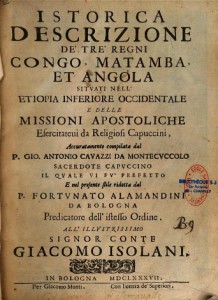
Was born, October 13, 1621, from humble beginnings in the village of Castle of Montecuccolo (now a suburb of Pavullo in Frignano), son of Caesar (Cesare) and Wilhelmine (Guglielmina), sharecroppers of count Massimiliano Montecuccoli, who gave it the name Galeotto.
In 1640 took at the end of the novitiate at the convent of the Capuchins of Cesena, with the intention of starting to missionary life. However, became a priest, his superiors judged him “good will” but “very little intelligence“, and its not enough studies to qualify as a preacher. In 1649 he presented to the Congregation of Propaganda Fide to be sent to Congo as a missionary, but once that possibility was rejected. However the Capuchin missions in Africa required a growing number of religious, and finally in 1653 the Bologna provincial Father it was suitable.
The November 11, 1654 he arrived aboard a Genoese ship, in Luanda, Portuguese Angola’s administrative capital, to travel to the Capuchin mission then of Matamba. In the early years he travelled with Portuguese soldiers through various locations the Angolan Northeastern (Cambambe, Massangano, Ambaca, Maupungu …). Here he began his preaching among trials of all kinds, from malarial fevers to cannibalism, writing numerous memos and Chronicles of these explorations.
Sick, he embarked on a ship to Brazil, where he waited a year a ship for Europe, arriving finally in 1668 in Lisbon. In Rome, he also showed to the superiors of Propaganda Fide the writings that had begun in 1655: these notes were considered interesting, and he was invited to apply Cavazzi an organic and complete work on the history of the Capuchin Mission in that part of the black continent, which were work devoted about three years and a long confrontation with the library and the documents of the Capuchins. While appreciating the work, the congregation was not, however, assume the burden of printing, and therefore was named the May 30, 1672 Cavazzi prefect of mission and sent back to Africa. Departed from Lisbon on July 16, 1673, and arrived in Luanda only on December 10 following: the ship had in fact sinking coasts of Benguela and Cavazzi was among the few survivors.
Already weak health, he suffered an additional physical decay that the Government ability inficiò of mission, making him feel from many unfit for the role of prefect. Especially the lack of qualification of preacher led some missionaries – probably eager to be promoted – to ask the Congregation of propaganda Fide its removal, which finally took place in may 1676.
He returned to Italy in 1677, where he wrote a second biographical report on deaths in Congo cappuccinos. He died at Genoa in July 1678, aged 56 years.
The first and most important work of Cavazzi, “Historica description of the three Kingdoms Congo, Matamba end Angola“ was published only eight years after his death. It is a descriptive history of considerable importance at the time, so that as early as 1694 German edition was published in 1732 and one in French. It took until the 20th century to see an edition in Portuguese.
In 1969 a modenese priest, Giuseppe Pistoni discovered between the cards Abdullah, a family town, three powerful original manuscripts of Cavazzi, then the revised text stylistically from Alamandini. This rehash was wanted by Propaganda Fide to purify the text to some miracolistici hints or imaginative, a work deemed long and painstaking that probably resulted in the posthumous publication. To this day remains one of the most interesting historical documentation not only on Africa Capuchin presence, but also an important testimony about oral traditions and usages of the Congolese and Angolan populations.
These manuscripts were also illustrated with vivid representations to watercolor of life in Central Africa, and especially of the Court of the Queen N’Zingha, who ruled the Zingha indomitable or, if you like, bloody tribe of Matamba, then dominant in Angola. “Never satolla of drinking the blood taking little baby and throttle for men empirne the nappi, goiter and the bowels”, writes father Cavazzi, the fierce Queen of the cannibals had a male harem in which men could sometimes end up eaten. Organized banquets in which lovers in female dresses were served “roasted mice with all the hair“, as disgusted the Capuchin Friar. However, sent by superiors Cavazzi bolognesi to evangelize the Matamba, do not subtract the harder task, which is to convert the exuberant Queen. There, on the merits, Zingha looks confused, or loves to mix. When he seems to have embraced the Christian faith, that falls within the animism and in tribalism. Then back to convert, then escapes again. Eventually capitulates and Christian dies at 81 years, assisted by who she was Cavazzi was called to replace Father Antonio da Gaeta remained to support the Prefecture of Angola.
In addition to this story, rewrote the Cavazzi biographies of some of its missionaries “The lives of Friars Minor Capuchin Lives of the order of the seraphic father Saint Francis, dead in Ethiopian Missions from the year 1645 until the year 1677″ (manuscript preserved at the library of Évora), work was not published before the 20th century. They don’t have the accuracy of the first work, since he had no Cavazzi time to integrate them with archival research, but contain valuable news about Capuchin presence in Congo in ‘ 600.
Istorica Descrizione de’ Tre Regni Congo, Matamba, et Angola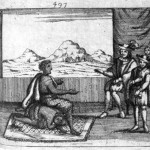
When Nzinga entered a room to meet with the Portuguese, she observed that the Portuguese governor of Luanda was seated on the only chair; she immediately summoned one of her female retainers who fell upon her hands and knees and became her “seat.” Cavazzi (who writes the Queen’s name as Zingha) witnessed this scene, apparently in astonishment.
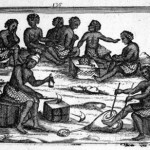 Depicts various phases of metalworking, including use of bellows.
Depicts various phases of metalworking, including use of bellows.
Queen Nzinga and a drummer, Kingdom of Kongo, 1670s.
Queen Nzinga and her entourage.
A Cappuccino in black Africa of the seventeenth century:
The designs of the Manuscripts Heralds of Father Giovanni Antonio Cavazzi from Montecuccolo.
Foreground shows the “first king of Ndongo” forging weapons and utensils; in background (left) the use of bellows and (right) royal spectators.
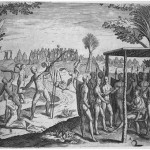 Theodore and Johan Israel De Bry, Indiae Orientalis pars VI.
Theodore and Johan Israel De Bry, Indiae Orientalis pars VI.
A depiction of the court and administration of justice. Seven features are indentified, labelled from A to G; for example, (A) the king or chief listening to a case presented to him, (B) the beheading of a man who killed a Dutchman, (D) a woman drinking from a jug and swearing an oath to her husband that she had nothing to do with other men, (F) persons dissatisfied with the chief’s verdict fight it out among themselves, (G) women mourning those who are condemned.
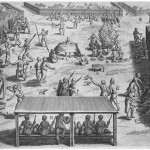 Theodore and Johan Israel De Bry, Indiae Orientalis pars VI.
Theodore and Johan Israel De Bry, Indiae Orientalis pars VI.
Eighteen features, labelled from A to S, are identified in this illustration; they include (A) the home of the chief, (D) farmers selling palm wine, (E) the chicken market, (K) sugar cane being sold, (O) Dutch visiting the market, (R) the road to Mina (Elmina).
Read the following blogs : (When necessary use translators)

